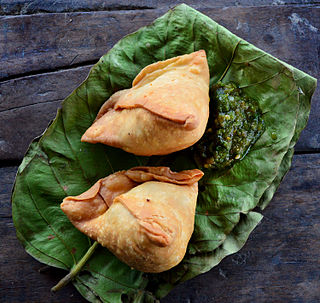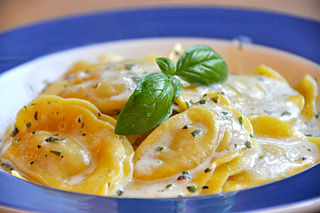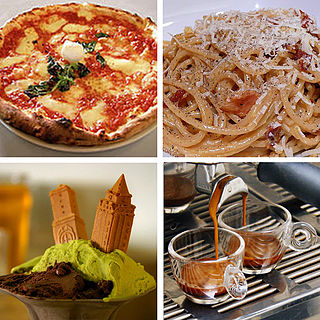
Filled pasta or stuffed pasta is pasta, usually sealed, surrounding a variety of fillings. Such pasta is especially common in non-tropical regions of Eurasia. Examples of filled pasta include ravioli and tortellini.

Filled pasta or stuffed pasta is pasta, usually sealed, surrounding a variety of fillings. Such pasta is especially common in non-tropical regions of Eurasia. Examples of filled pasta include ravioli and tortellini.
The pasta wrappers are usually fresh pasta, but dried pasta can be used if the wrapper is not sealed. Premade filled pasta for mass consumption is often pasteurized to set the dough structure. [1]
While most filled pastas are sealed on all sides, rotolo ripieno is rolled, but not sealed. [2] Similar types of pasta include layered pasta such as lasagna, while similar stuffed preparations include kachoris, samosas and tamales.

Pasta is a type of food typically made from an unleavened dough of wheat flour mixed with water or eggs, and formed into sheets or other shapes, then cooked by boiling or baking. Pasta was traditionally only made with durum, although the definition has been expanded to include alternatives for a gluten-free diet, such as rice flour, or legumes such as beans or lentils. While Asian noodles are believed to have originated in China, pasta is believed to have independently originated in Italy and is a staple food of Italian cuisine, with evidence of Etruscans making pasta as early as 400 BCE in Italy.

Tomato sauce can refer to many different sauces made primarily from tomatoes, usually to be served as part of a dish, rather than as a condiment. Tomato sauces are common for meat and vegetables, but they are perhaps best known as bases for sauces for Mexican salsas and Italian pasta dishes. Tomatoes have a rich flavor, high water content, soft flesh which breaks down easily, and the right composition to thicken into a sauce when stewed, without the need for thickeners such as roux or masa. All of these qualities make them ideal for simple and appealing sauces.

Hungarian or Magyar cuisine is the cuisine characteristic of the nation of Hungary, and its primary ethnic group, the Magyars. Hungarian cuisine has been described as being the spiciest cuisine in Europe. This can largely be attributed to the use of their piquant native spice, Hungarian paprika, in many of their dishes. A mild version of the spice, Hungarian sweet paprika, is commonly used as an alternative. Traditional Hungarian dishes are primarily based on meats, seasonal vegetables, fruits, bread, and dairy products.

Pierogi or pierogies are filled dumplings, made by wrapping unleavened dough around a filling, and occasionally flavored with a savory or sweet garnish, finally cooked in boiling water.

A samosa is a fried central Asian pastry with a savoury filling, including ingredients such as spiced potatoes, onions, peas, meat, or fish. It is made into different shapes, including triangular, cone, or crescent, depending on the region. Samosas are often accompanied by chutney, and have origins in medieval times or earlier. Sweet versions are also made. Samosas are a popular entrée, appetizer, or snack in the cuisines of South Asia, the Middle East, Central Asia, East Africa and their South Asian diasporas.

Ravioli are a type of stuffed pasta comprising a filling enveloped in thin pasta dough. Usually served in broth or with a sauce, they originated as a traditional food in Italian cuisine. Ravioli are commonly square, though other forms are also used, including circular and semi-circular (mezzelune).

Kreplach are small dumplings in Ashkenazi Jewish cuisine filled with ground meat, mashed potatoes or another filling, usually boiled and served in chicken soup, though they may also be served fried. They are similar to Polish pierogi, Polish and Ukrainian uszka, Russian pelmeni, Italian ravioli or tortellini, German Maultaschen, and Chinese jiaozi and wonton. The dough is traditionally made of flour, water and eggs, kneaded and rolled out thin. Some modern-day cooks use frozen dough sheets or wonton wrappers. Ready-made kreplach are also sold in the kosher freezer section of supermarkets.

Cannelloni are a cylindrical type of egg-based stuffed pasta generally served baked with a filling and covered by a sauce in Italian cuisine. Popular stuffings include spinach and ricotta or minced beef. The shells are then typically covered with tomato sauce.

Cypriot cuisine is the cuisine of the island of Cyprus, shared by both Greek Cypriots and Turkish Cypriots.The national dish is seftalia (greek:σεφταλιά)

Manti is a type of dumpling mainly found in Armenian cuisine, Turkish cuisine and Central Asian cuisine but also in West Asia, South Caucasus, and the Balkans. Manti is also popular among Chinese Muslims, and it is consumed throughout post-Soviet countries, where the dish spread from the Central Asian republics. The dumplings typically consist of a spiced meat mixture, usually lamb or ground beef, wrapped in a thin dough sheet which is then boiled or steamed. The size and shape of manti vary significantly depending on geographic location.

Italian cuisine is a Mediterranean cuisine consisting of the ingredients, recipes and cooking techniques developed in Italy since Roman times and later spread around the world together with waves of Italian diaspora. Some of these foods were imported from other cultures. Significant changes occurred with the colonization of the Americas and the introduction of potatoes, tomatoes, capsicums, maize and sugar beet—the latter introduced in quantity in the 18th century. It is one of the best-known and most appreciated gastronomies worldwide.

Stuffed peppers is a dish common in many cuisines. It consists of hollowed or halved bell peppers filled with any of a variety of fillings, often including meat, vegetables, cheese, rice, or sauce. The dish is usually assembled by filling the cavities of the peppers and then cooking.

Neapolitan cuisine has ancient historical roots that date back to the Greco-Roman period, which was enriched over the centuries by the influence of the different cultures that controlled Naples and its kingdoms, such as that of Aragon and France.

Mezzelune, also known as Schlutzkrapfen in South Tyrol, Tyrol and neighbouring German-speaking regions, and as crafuncins or cajincì in Ladin-speaking regions, are a semi-circular stuffed pasta, similar to ravioli or pierogi. The dough is usually made of white flour or buckwheat flour, durum semolina, mixed with eggs and olive oil. Typical fillings may include cheese, spinach, or mushrooms. There are also recipes with potato, meat, red beet, or sauerkraut filling. The dish may be served with mushroom or pesto sauce, with Italian sausage, with seafood, and/or with cherry tomatoes.

Dumpling is a broad class of dishes that consist of pieces of cooked dough, often wrapped around a filling. The dough can be based on bread, wheat or other flours, or potatoes, and it may be filled with meat, fish, tofu, cheese, vegetables, or a combination. Dumplings may be prepared using a variety of cooking methods and are found in many world cuisines.

Lumpia are various types of spring rolls from Indonesia and the Philippines. Lumpia are made of thin paper-like or crepe-like pastry skin called "lumpia wrapper" enveloping savory or sweet fillings. It is often served as an appetizer or snack, and might be served deep-fried or fresh (unfried). Lumpia are Indonesian and Filipino adaptations of the Fujianese rùnbǐng and Teochew popiah, usually consumed during Qingming Festival.

A wonton is a type of Chinese dumpling commonly found across regional styles of Chinese cuisine. It is also spelled wantan or wuntun in transliteration from Cantonese 雲吞 / 云吞 and wenden from Shanghainese 餛飩 / 馄饨. Even though there are many different styles of wonton served throughout China, Cantonese wontons are the most popular in the West due to the predominance of Cantonese restaurants overseas.

Apulian cuisine consists of the cooking traditions and practices of the region of Apulia in Italy. Starting from the Middle Ages the permanent residence of the nobility in the region gradually declined, which caused the disappearance of their noble cuisine over time. As the common people suffered from poverty, their culinary tradition adapted to use cheap and simple foods. Bread, vegetables and pasta have the leading role in the cuisine. Fruits, fish and wine are consumed frequently as well, but meat plays a minor role. The food of Apulia is known as a prime example of cucina povera or 'cuisine of the poor', characterizing its simplicity rather than its quality. Moreover, the simple dishes allow the quality of their local and seasonal ingredients to take center stage.